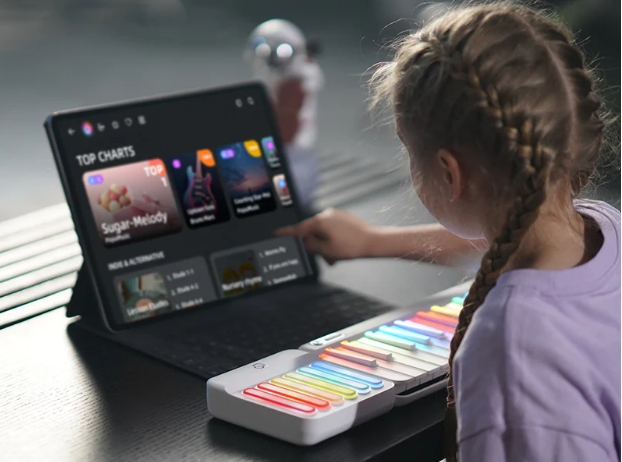
You’ve probably heard folks say “electric piano,” “keyboard,” or “digital piano” as if they’re all the same instrument. Yet search engines still get the question “what is an electric piano called” thousands of times each month. So let’s clear up the confusion, shine a light on the modern options, & help you pick the perfect keys for your music journey.
Strictly speaking, an electric piano is a keyboard that generates sound with electro‑mechanical parts—think tines, reeds, or metal bars—picked up by magnetic pickups & pumped through an amp. Classic examples: the Fender Rhodes & Wurlitzer. Most people today, however, use the term loosely for any electric keyboard piano that plugs into a wall & doesn’t have strings. Language evolves. We roll with it.
Manufacturers realized players wanted the feel of a traditional piano without the tuning headaches. Enter the digital piano (sometimes branded “stage piano” or “piano electric keyboard”) in the late ’80s. Instead of vibrating metal, digital models store meticulously sampled acoustic‑piano sounds on chips. When you press a key, tiny computers trigger the sample through built‑in speakers. Close your eyes—hard to tell the difference. Pretty neat.
|
Term |
Core Sound Source |
Typical Use Case |
|
Electric Piano |
Mechanical (tines/reeds) + pickups |
Vintage jazz, soul, indie rock |
|
Electronic Keyboard |
Synthesized waveforms |
EDM, sound design, classroom music |
|
Digital Piano |
Sampled acoustic piano |
Home practice, stage gigs, worship bands |
Knowing what each instrument is called helps you shop smarter. A store associate who hears “electric piano keyboard” may steer you to a Yamaha P‑series. Ask for a “vintage electric piano” & you’ll likely be shown a refurbished Rhodes or a modern clone. Same wallet, wildly different sound.
If you’re browsing for something fresh, check out the PopuPiano Smart Keyboard. It shrinks a full‑size keybed into a sleek, modular chassis that snaps to a wireless chord pad—ideal for songwriting on a café table. Light‑guided keys nudge beginners toward correct fingering, & the companion app gamifies scales like a rhythm game. Few rivals blend portability, learning tools, & a genuinely musical key feel this well.
Digital pianos live or die by their key action. You want resistance that encourages proper technique without fatiguing your wrists. Hammer‑action models simulate the feel of a real grand by using pivot‑mounted hammers that swing when you press a key. Semi‑weighted actions split the difference—lighter, but still controllable. Unweighted (“synth action”) is fine for organ sweeps or EDM chops, yet less helpful for Rachmaninoff. Choose wisely.
Even a budget electric piano keyboard with stellar samples falls short if the keys wobble. Touch sensitivity (how well velocity maps to volume) & escapement (a tiny “notch” on key release) contribute to expressive playing. Test these in person when possible. Your fingers will thank you.
These small jacks make a huge difference in daily use.
Apartments & dorms love digital pianos because you can practise silently with closed‑back headphones. Some consoles even sport folding key covers that double as sheet‑music stands. Measure your desk or corner nook before ordering; 88‑key boards stretch roughly 52 inches.
Electric & digital pianos range from a couple of hundred dollars to mid‑four figures. Factor in:
Keep liquids far away, wipe the surface with a microfiber cloth, & cover the keybed when not in use. For vintage electromechanical models, periodic tine alignment & pickup height adjustments keep the tone sparkling. Digital boards, meanwhile, will outlive your laptop if you treat them gently.
And if you detour into synth leads or chord pads? Totally cool—creativity counts as practice.
Not exactly. Traditional electric pianos use mechanical parts; digital pianos emulate them with samples. Yet retailers often group both under “electric keyboard piano.” Context matters.
A full 88 keys build proper finger stretch & repertoire range. Still, a 61‑key electric piano keyboard can cover pop tunes & spare precious desk space.
For classical technique, yes. If your goals lean toward synths or beat‑making, semi‑weighted might suffice.
Prices shift, but look for models with graded‑hammer action, 128‑note polyphony, & onboard speakers loud enough to fill a living room. Brands like Korg, Roland, & Yamaha dominate this bracket; the PopuPiano Smart Keyboard adds mobile‑friendly features if you crave portability.
The phrase “electric piano” first appeared in the 1920s with the Neo‑Bechstein electric grand. But the sound we recognize today blossomed in the ’60s when the Rhodes suitcase model hit jazz clubs. Its bell‑like tone defined Miles Davis’s fusion era & still colors neo‑soul records. Knowing that lineage deepens your appreciation—and might inspire your next chord voicing.
Choosing the right keyboard is less about chasing specs & more about finding a responsive partner in creativity. Whether you end up with a wooden‑cased digital console, a suitcase‑style electric relic, or the backpack‑friendly PopuPiano Smart Keyboard, the real magic happens once you press those first notes. Let them pull you in. & keep playing—your future self will thank you for every minute spent at the keys.
Read more

Is a Piano Really an Instrument? Breaking Down the Music Science
Is a piano an instrument? At first glance, the answer seems obvious, but dig a little deeper, & things get more interesting. Unlike most instruments that fall neatly into one category, the pian...

Exploring the Different Types of Piano Keyboards for Every Player
You’ve probably noticed that “keyboard” gets tossed around to describe just about anything with black‑and‑white keys. Yet walk into any music store (virtual or brick‑and‑mortar) and you’ll see doze...